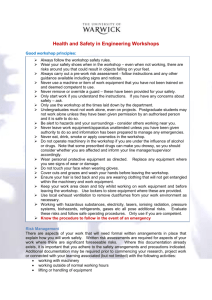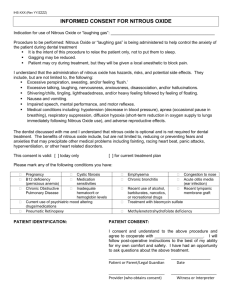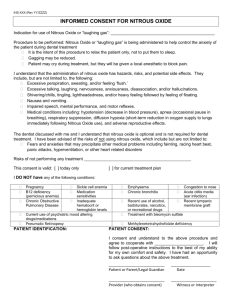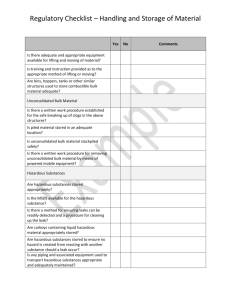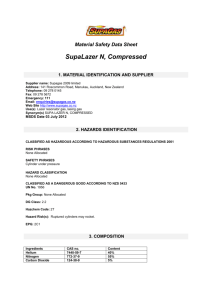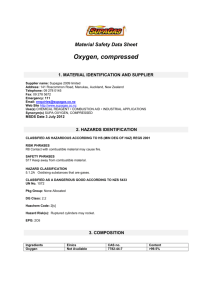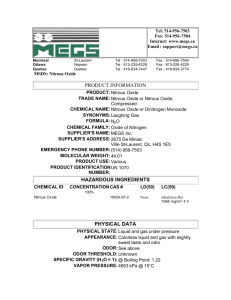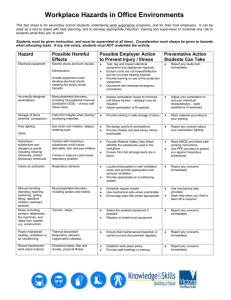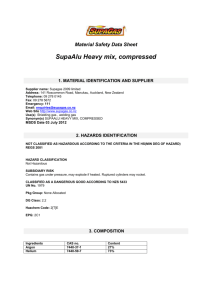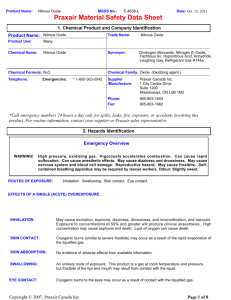Material Safety Data Sheet Nitrous Oxide Compressed
advertisement
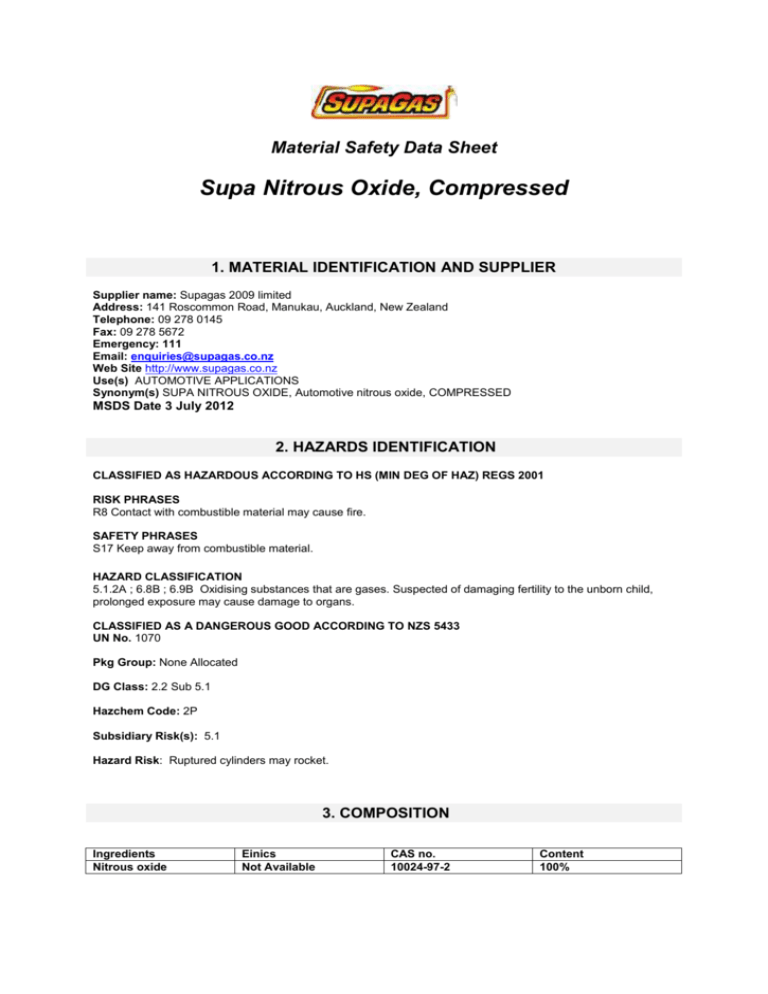
Material Safety Data Sheet Supa Nitrous Oxide, Compressed 1. MATERIAL IDENTIFICATION AND SUPPLIER Supplier name: Supagas 2009 limited Address: 141 Roscommon Road, Manukau, Auckland, New Zealand Telephone: 09 278 0145 Fax: 09 278 5672 Emergency: 111 Email: enquiries@supagas.co.nz Web Site http://www.supagas.co.nz Use(s) AUTOMOTIVE APPLICATIONS Synonym(s) SUPA NITROUS OXIDE, Automotive nitrous oxide, COMPRESSED MSDS Date 3 July 2012 2. HAZARDS IDENTIFICATION CLASSIFIED AS HAZARDOUS ACCORDING TO HS (MIN DEG OF HAZ) REGS 2001 RISK PHRASES R8 Contact with combustible material may cause fire. SAFETY PHRASES S17 Keep away from combustible material. HAZARD CLASSIFICATION 5.1.2A ; 6.8B ; 6.9B Oxidising substances that are gases. Suspected of damaging fertility to the unborn child, prolonged exposure may cause damage to organs. CLASSIFIED AS A DANGEROUS GOOD ACCORDING TO NZS 5433 UN No. 1070 Pkg Group: None Allocated DG Class: 2.2 Sub 5.1 Hazchem Code: 2P Subsidiary Risk(s): 5.1 Hazard Risk: Ruptured cylinders may rocket. 3. COMPOSITION Ingredients Nitrous oxide Einics Not Available CAS no. 10024-97-2 Content 100% 4. FIRST AID MEASURES Eye Skin Not Irritating to the eye. Exposure is considered unlikely. Inhalation Remove from area of exposure immediately. Inhalation of small amounts of nitrous oxide may produce euphoria. Large doses mixed with oxygen induce anaesthesia. High concentrations inhaled for a few seconds may cause hysterical laughter or apparent intoxication. Nitrous oxide despite being an oxidiser does not replace the oxygen in the body. Exposure levels exceeding 90% minimising the oxygen past 10% will cause death. Ingestion is considered unlikely. However, should ingestion occur, contact a Poison Information Centre on 0800764 766 (0800 POISON) or +643 479 7248 (New Zealand) or a doctor. Treat symptomatically Ingestion Advice to Doctor 5. FIRE FIGHTING MEASURES Fire and Explosion Non flammable gas. Temperatures in a fire may cause cylinders to rupture and internal pressure relief devices to be activated. Call fire brigade. This product will vigorously support combustion may ignite combustibles (wood, paper, oil, clothing, etc). Do not approach cylinders suspected to be hot. Remove cool cylinders from the path of the fire if safe to do so. Ensure working area is well ventilated before re-use. Notify the manufacturer that you will be returning a faulty cylinder. Residual product will disposed of when the cylinder is returned. Extinguishing Non flammable. Use water fog to cool containers from protected area. Flammability Non flammable - oxidising agent. Oil/grease can spontaneously ignite at low temperatures in oxygen enriched atmospheres. Many other materials, which do not burn in air, will vigorously burn in pure oxygen. Hazchem Code 2P 6. ACCIDENTAL RELEASE MEASURES Spillage GAS CYLINDERS: If the cylinder is leaking, eliminate all potential ignition sources and evacuate area of personnel. Inform manufacturer/supplier of leak. Wear appropriate PPE and if safe to do so carefully move it to a well ventilated remote area, then allow to discharge. Do not attempt to repair leaking valve or cylinder safety devices. Personal protection: Do not smoke while handling this product. Persons moving cylinders should be provided with safety footwear, safety glasses and leather or PVC gloves. Full cover overalls are recommended. All personal protective equipment must be free from oil and grease. 7. STORAGE AND HANDLING Handling Before use carefully read the product label. Use of safe work practices are recommended to avoid eye or skin contact and inhalation. Observe good personal hygiene, including washing hands before eating. Prohibit eating, Drinking and smoking in contaminated areas. Approved handlers required for use of this product (test certification required) , refer to the HASNO regulations 2001 for more information. Storage Do not store near sources of ignition or incompatible materials. Cylinders should be stored below 45º C in a secure area, upright and restrained to prevent cylinders from falling. Cylinders should also be stored in a dry, well Ventilated area constructed of non-combustible material with firm level floor (preferably concrete), away from areas of heavy traffic and emergency exits. Approved handlers are required if more than 200m3 is stored on site. 8. EXPOSURE CONTROLS / PERSONAL PROTECTION Exposure Standards Work safe exposure standard TWA for nitrous Oxide is 25ppm. Biological Limit Values No biological limit allocated. Engineering Controls Do not inhale gas. Do not allow backfeed. Use in well ventilated areas with good extraction. Maintain vapour levels below the recommended exposure standard. Use only the required equipment suitable for nitrous oxide. Wear safety boots, leather gloves and safety glasses. Personal Protection Equipment 9. PHYSICAL AND CHEMICAL PROPERTIES Appearance : Colourless gas Odour: sweetish odour PH: Not Available Vapour pressure: 4600kpa@ 25ºc Vapour Density: Not Available Boiling point: 88.47ºc Melting point: not available Evaporation rate; not available Critical Temperature: 36.41ºc Solubility (Water) : 1.37 kg/m3 Specific gravity: 1.53 % Volatiles : Not Available Flammability: Non Flammable Flash point: Not relevant Upper explosion limit: Not Relevant Lower explosion limit: not relevant Autoignition Temperature: not available Density: 1.874 kg/m3 10. STABILITY AND REACTIVITY Material to Avoid Oil and grease can spontaneously ignite at low temperatures in oxygen enriched atmospheres. Many other materials, which do not burn in air, will vigorously burn in pure oxygen. All non-metals must be oxygen compatible. Copper is most commonly used metal. Metals can be ignited and will continue to burn in pure oxygen atmospheres under specific conditions of temperature and pressure. Decomposition May evolve toxic gases if heated to decomposition. 11. TOXICOLOGICAL INFORMATION Health Hazard Summary Suspected of damaging fertility or the unborn child. May cause damage to organs through prolonged or repeated exposure. Eye Non irritating. Beware of liquid vapours evaporating as this can cause Inhalation Non-irritant. Anaesthetic, As the amount of Nitrous oxide inhaled is increased may inactivate vitamin B12 resulting in changes in the bone marrow. Heavy exposure and addiction may result in myeloneuropathy and sub acute combined degeneration. Skin Non irritating. May cause cold burns in the event of contact to the skin, remove clothing immediately and flush affected areas with warm water for a period of 15 minutes. Seek medical attention. Ingestion Due to product form, ingestion is considered highly unlikely. Toxicity Data Nitrous oxide (10024-97-2) LC50 inhalation : 1068 mg/m3 12. ECOLOGICAL INFORMATION Environment When discharged in large quantities may contribute to the greenhouse effect. Global warming factor (co2=1): 310 13. DISPOSAL CONSIDERATIONS Waste Disposal Cylinders should be returned to the manufacturer or supplier for disposal of contents. Legislation Dispose of in accordance with relevant local legislation. 14. TRANSPORT INFORMATION Transport Ensure cylinder is separated from driver and that outlet of relief device is not obstructed. Ensure the driver is aware of potential hazards and actions necessary in the event of an accident or emergency. Before commencing transporting of Cylinders ensure: containers are firmly secured. cylinder valve is closed and not leaking. there is adequate ventilation. compliance with applicable regulations has been achieved. CLASSIFIED AS A DANGEROUS GOOD ACCORDING TO NZS 5433 Shipping Name : Supa nitrous oxide, Compressed UN No. 1070 DG Class: 2.2 sub 5.1 Pkg Group: None Allocated Hazchem Code: 2P Subsidiary Risk(s): 5.1 15. REGULATORY INFORMATION Group Name Supa Nitrous Oxide Compressed EPA Approval Number HSR001065 UN No. 1070 HSNO Controls: Hazardous Substances (Classes 1 to 5 Controls) Regulations 2001. Hazardous Substances (Classes 6, 8, and 9 Controls) Regulations 2001. Hazardous Substances (Disposal) Regulations 2001. Hazardous Substances (Personnel Qualifications) Regulations 2001. Hazardous Substances (Emergency Management) Regulations 2001. Hazardous Substances (Identification) Regulations 2001. Hazardous Substances (Compressed Gases) Regulations 2004. Hazardous Substances (Tank Wagon and Transportable Containers) Regulations 2004. Schedule 12 of the Hazardous Substances (Dangerous Goods and Scheduled Toxic Substances) Transfer Notice 2004. Approved Handler: Approved handlers are required if more than 250 kg is stored on site. 16. OTHER INFORMATION Additional Information This product is used in the Automotive industry for the application of enhancement to increase the performance of engines through added combustion. It is supplied in a light blue coloured cylinder. APPLICATION METHOD: Gas regulator of suitable pressure and flow rating fitted to cylinder or manifold with low pressure gas distribution to equipment. ABBREVIATIONS: mg/m3 - Milligrams per cubic metre ppm - Parts Per Million TWA/ES - Time Weighted Average or Exposure Standard. CNS - Central Nervous System NOS - Not Otherwise Specified pH - relates to hydrogen ion concentration - this value will relate to a scale of 0 - 14, where 0 is highly acidic and 14 is highly alkaline. CAS# - Chemical Abstract Service number - used to uniquely identify chemical compounds. M - moles per litre, a unit of concentration. IARC - International Agency for Research on Cancer. HSNO –Hazardous substances and new organisms act 1996. PERSONAL PROTECTIVE EQUIPMENT GUIDELINES: The recommendation for protective equipment contained within this report is provided as a guide only. Factors such as method of application, working environment, quantity used, product concentration and the availability of engineering controls should be considered before final selection of personal protective equipment is made. HEALTH EFFECTS FROM EXPOSURE: It should be noted that the effects from exposure to this product will depend on several factors including: frequency and duration of use; quantity used; effectiveness of control measures; protective equipment used and method of application. Given that it is impractical to prepare a report which would encompass all possible scenarios, it is anticipated that users will assess the risks and apply control methods where appropriate. This MSDS summarises to our best knowledge, at the date of issue, the health and safety hazard information regarding this product and general guidance on how to safely handle the product in the workplace. All due care has been taken to include accurate and up-to-date information in this MSDS. Each user should read this MSDS and consider the information in the context of how the product will be handled and used in the workplace in conjunction with other products. If clarification or further information is needed to ensure that an appropriate risk assessment can be made, the user should contact Supagas 2009 Ltd. As far as lawfully possible, no liability for any loss, injury or damage (including consequential loss) which may be suffered or incurred by any person as a consequence of their reliance on the information contained in this MSDS can be accepted. Our responsibility for products sold is subject to our standard terms and conditions, a copy of which is available on request. This MSDS has been prepared in accordance with NZCIC Code of Practice – Preparation of Safety Data Sheets. This MSDS is subject to change without notice, for the latest version of this MSDS visit www.supagas.co.nz Reviewed 03 July 2012.
